
Willows, also called sallows and osiers, of the genus Salix, comprise around 350 species of typically deciduous trees and shrubs, found primarily on moist soils in cold and temperate regions.

Betula pendula, commonly known as silver birch, warty birch, European white birch, or East Asian white birch, is a species of tree in the family Betulaceae, native to Europe and parts of Asia, though in southern Europe, it is only found at higher altitudes. Its range extends into Siberia, China, and southwest Asia in the mountains of northern Turkey, the Caucasus, and northern Iran. It has been introduced into North America, where it is known as the European white birch or weeping birch and is considered invasive in some states in the United States and parts of Canada. The tree can also be found in more temperate regions of Australia.
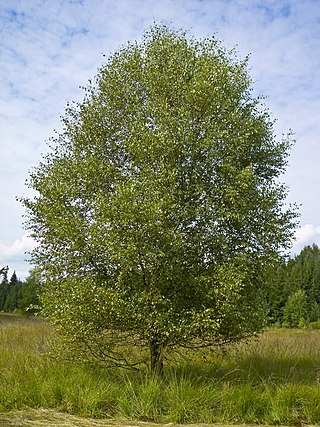
Betula pubescens, commonly known as downy birch and also as moor birch, white birch, European white birch or hairy birch, is a species of deciduous tree, native and abundant throughout northern Europe and northern Asia, growing farther north than any other broadleaf tree. It is closely related to, and often confused with, the silver birch, but grows in wetter places with heavier soils and poorer drainage; smaller trees can also be confused with the dwarf birch.

Salix caprea, known as goat willow, pussy willow or great sallow, is a common species of willow native to Europe and western and central Asia.

Salix purpurea, the purple willow, purpleosier willow, or purple osier, is a species of willow native to most of Europe and western Asia north to the British Isles, Poland, and the Baltic States.

Salix × fragilis, with the common names crack willow and brittle willow, is a hybrid species of willow native to Europe and Western Asia. It is native to riparian habitats, usually found growing beside rivers and streams, and in marshes and water meadow channels. It is a hybrid between Salix euxina and Salix alba, and is very variable, with forms linking both parents.
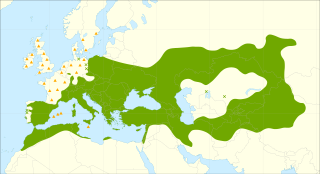
Populus alba, commonly called silver poplar, silverleaf poplar, or white poplar, is a species of poplar, most closely related to the aspens. It is native to a region spanning from the Atlas Mountains of Africa, through most of South and Central Europe, into Central Asia; it has been introduced to many temperate, moist regions worldwide. It grows in moist sites, often by watersides, in regions with hot summers and cold to mild winters.
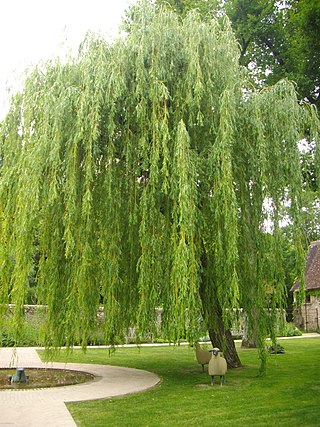
Salix babylonica is a species of willow native to dry areas of northern China, but cultivated for millennia elsewhere in Asia, being traded along the Silk Road to southwest Asia and Europe.

Salicin is an alcoholic β-glucoside. Salicin is produced in willow (Salix) bark. It is a biosynthetic precursor to salicylaldehyde.

Salix integra is a species of willow native to north-eastern China, Japan, Korea and the far south-eastern Russia.

Populus tremula is a species of poplar native to cool temperate regions of the Old World.

Salix magnifica is a species of willow in the family Salicaceae. It is endemic to Sichuan in southwestern China, where it grows at high altitudes of 2,100–3,000 m above sea level. It is threatened by habitat loss.
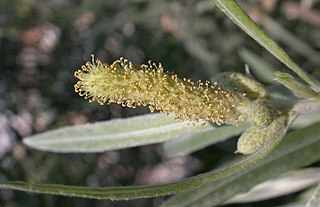
Salix exigua is a species of willow native to most of North America except for the southeast and far north, occurring from Alaska east to New Brunswick, and south to northern Mexico. It is considered a threatened species in Massachusetts while in Connecticut, Maryland, and New Hampshire it is considered endangered.

Salix triandra, with the common names almond willow, almond-leaved willow or black maul willow, is a species of willow native to Europe and Western and Central Asia. It is found from south-eastern England east to Lake Baikal, and south to Spain and the Mediterranean east to the Caucasus, and the Alborz Mountains. It usually grows in riparian habitats, on river and stream banks, and in wetlands.

Salix acutifolia, also known as Siberian violet-willow, long-leaved violet willow or sharp-leaf willow, is a species of flowering plant in the family Salicaceae, native to Russia and eastern Asia. It is a spreading, deciduous shrub or tree, growing to 10 m (33 ft) tall by 12 m (39 ft) wide. The young shoots are deep purple with a white bloom. The leaves are narrow, up to 10 cm (4 in) long. The catkins are produced in early spring, before the leaves. Older bark has a fine, netted pattern.
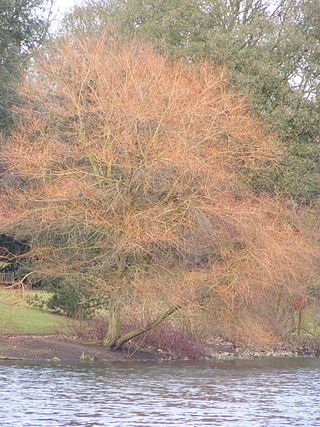
The Salix Sepulcralis Group is a cultivar group containing all cultivars of hybrids between Salix alba and Salix babylonica. The trees in this group are sometimes referred to as white weeping willow or glaucous weeping willow in reference to the mixed appearance from the parent species. It was first described by L. Simonkai in 1890 from trees growing in Romania. The group contains both weeping and nonweeping cultivars, though the best-known of its cultivars is 'Chrysocoma', the most widely grown weeping tree..
Some of the cultivars are hybrids of S. babylonica var. matsudana 'Tortuosa' and have inherited from its parent the twisted and contorted branches, as well as being more cold-tolerant, as S. babylonica var. matsudana is native to northern China and Korea.

Salix × sepulcralis 'Chrysocoma', or Weeping Golden Willow, is the most popular and widely grown weeping tree in the warm temperate regions of the world. It is an artificial hybrid between S. alba 'Vitellina' and S. babylonica. The first parent provides the frost hardiness and the golden shoots and the second parent the strong weeping habit.
This cross was originally made at the Späth Nursery and was first mentioned in their 1888 nursery catalogue as S. vitellina pendula nova.
Being a cultivar from the Chrysocoma Group, which includes all crosses between S. alba and S. babylonica, it is much hardier and more long-lived than the Babylon Willow. This particular cultivar is easily distinguished from the other Golden Weeping Willow by its androgynous catkins.

Salix alaxensis is a species of flowering plant in the willow family known by the common names Alaska willow and feltleaf willow. It is native to northern North America, where it occurs throughout Alaska and northwestern Canada.

Betula albosinensis, the Chinese red birch, syn. B. bhojpattra var. sinensis, B. utilis var. sinensis, is a species of birch in the family Betulaceae, native to Western China. It is a deciduous tree growing to 25 metres (82 ft). A particular feature is the peeling brown bark. In fact the Latin specific name albosinensis means "white, from China". Brown catkins are produced in Spring.

Salix euxina, the eastern crack-willow, is a species of flowering plant in the willow family Salicaceae, native from Turkey to the Caucasus. It was first described by I. V. Belyaeva in 2009. It is one of the parents of the common crack-willow, Salix × fragilis.
























